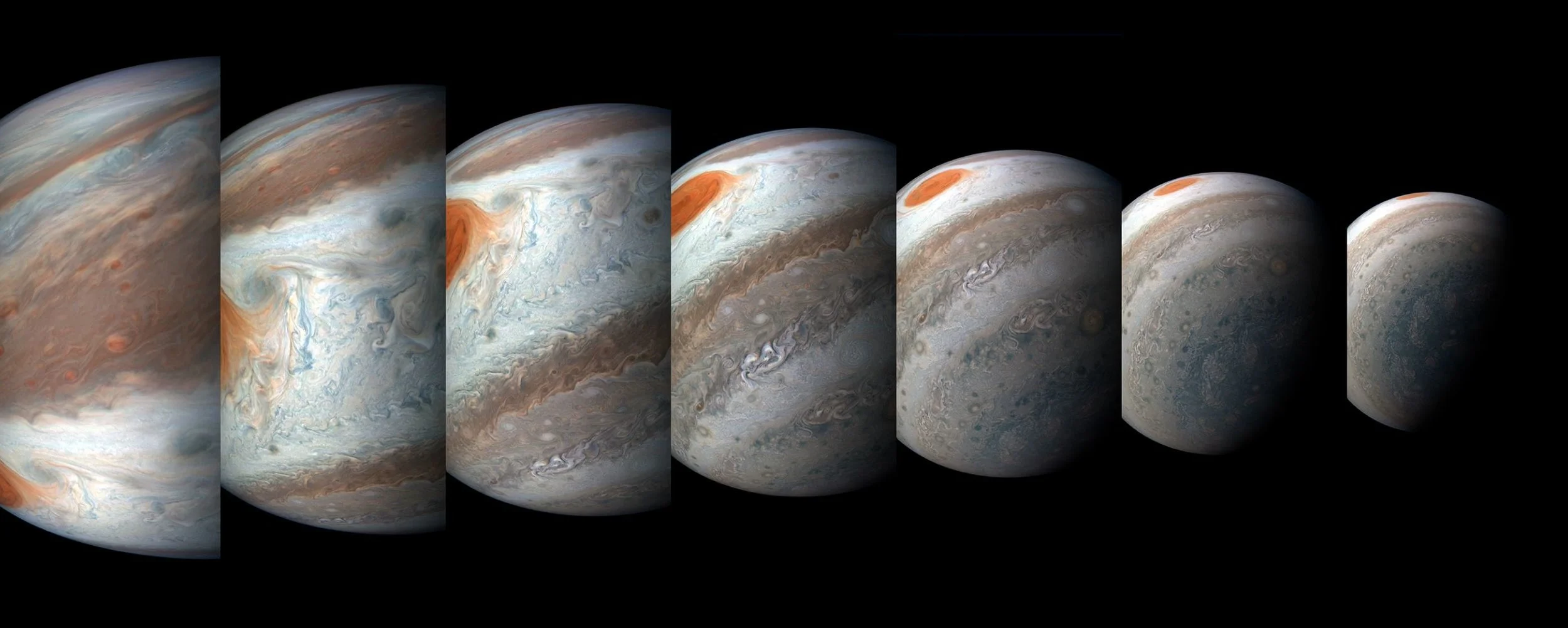Any comments, suggestions or just looking for a chat about this subject? Don't hesitate and leave a comment on our improved comment section down below the article!
A south tropical disturbance has just passed Jupiter's iconic Great Red Spot and is captured stealing threads of orange haze from the Great Red Spot in this series of color-enhanced images from NASA's Juno spacecraft. From left to right, this sequence of images was taken between 2:57 a.m. and 3:36 a.m. PDT (5:57 a.m. and 6:36 a.m. EDT) on April 1, 2018, as the spacecraft performed its 12th close flyby of Jupiter. Citizen scientists Gerald Eichstädt and Seán Doran created this image using data from the spacecraft's JunoCam imager. - Image Credits: NASA/JPL-Caltech/SwRI/MSSS/Gerald Eichstädt/Seán Doran
On Dec. 21, at 8:49:48 a.m. PST (11:49:48 a.m. EST) NASA's Juno spacecraft will be 3,140 miles (5,053 kilometers) above Jupiter's cloud tops and hurtling by at a healthy clip of 128,802 mph (207,287 kilometers per hour). This will be the 16th science pass of the gas giant and will mark the solar-powered spacecraft's halfway point in data collection during its prime mission.
Juno is in a highly-elliptical 53-day orbit around Jupiter. Each orbit includes a close passage over the planet's cloud deck, where it flies a ground track that extends from Jupiter's north pole to its south pole.
With our 16th science flyby, we will have complete global coverage of Jupiter, albeit at coarse resolution, with polar passes separated by 22.5 degrees of longitude," said Jack Connerney, Juno deputy principal investigator from the Space Research Corporation in Annapolis, Maryland. "Over the second half of our prime mission — science flybys 17 through 32 — we will split the difference, flying exactly halfway between each previous orbit. This will provide coverage of the planet every 11.25 degrees of longitude, providing a more detailed picture of what makes the whole of Jupiter tick."
Launched on Aug. 5, 2011, from Cape Canaveral, Florida, the spacecraft entered orbit around Jupiter on July 4, 2016. Its science collection began in earnest on the Aug. 27, 2016, flyby. During these flybys, Juno's suite of sensitive science instruments probes beneath the planet's obscuring cloud cover and studies Jupiter's auroras to learn more about the planet's origins, interior structure, atmosphere and magnetosphere.
"We have already rewritten the textbooks on how Jupiter's atmosphere works, and on the complexity and asymmetry of its magnetic field," said Scott Bolton, principal investigator of Juno, from the Southwest Research Institute in San Antonio. "The second half should provide the detail that we can use to refine our understanding of the depth of Jupiter's zonal winds, the generation of its magnetic field, and the structure and evolution of its interior."
Two instruments aboard Juno, the Stellar Reference Unit and JunoCam, have proven to be useful not only for their intended purposes, but also for science data collection. The Stellar Reference Unit (SRU) was designed to collect engineering data used for navigation and attitude determination, so the scientists were pleased to find that it has scientific uses as well.
"We always knew the SRU had a vital engineering job to do for Juno," said Heidi Becker, Juno's radiation monitoring investigation lead at NASA's Jet Propulsion Laboratory in Pasadena, California. "But after making scientific discoveries in Jupiter's radiation belts and taking a first-of-its-kind image of Jupiter's ring, we realized the added value of the data. There is serious scientific interest in what the SRU can tell us about Jupiter."
The JunoCam imager was conceived as an outreach instrument to bring the excitement and beauty of Jupiter exploration to the public.
A multitude of bright white "pop-up" storms in this Jupiter cloudscape appear in this image from NASA's Juno spacecraft. This color-enhanced image was taken at 1:55 p.m. PDT (4:55 p.m. EDT) on Oct. 29, 2018, as the spacecraft performed its 16th close flyby of Jupiter. Citizen scientists Gerald Eichstädt and Seán Doran created this image using data from the spacecraft's JunoCam imager. - Image Credit: NASA/JPL-Caltech/SwRI/MSSS/Gerald Eichstädt/Seán Doran
"While originally envisioned solely as an outreach instrument to help tell the Juno story, JunoCam has become much more than that," said Candy Hansen, Juno co-investigator at the Planetary Science Institute in Tucson, Arizona. "Our time-lapse sequences of images over the poles allow us to study the dynamics of Jupiter's unique circumpolar cyclones and to image high-altitude hazes. We are also using JunoCam to study the structure of the Great Red Spot and its interaction with its surroundings."
The SRU and JunoCam teams both now have several peer-reviewed science papers —either published or in the works — to their credit.
NASA's JPL manages the Juno mission for the principal investigator, Scott Bolton, of the Southwest Research Institute in San Antonio. Juno is part of NASA's New Frontiers Program, which is managed at NASA's Marshall Space Flight Center in Huntsville, Alabama, for NASA's Science Mission Directorate. The Italian Space Agency (ASI) contributed two instruments, a Ka-band frequency translator (KaT) and the Jovian Infrared Auroral Mapper (JIRAM). Lockheed Martin Space in Denver built the spacecraft.
Source: NASA press release
If you enjoy our selection of content please consider following Universal-Sci on social media:











